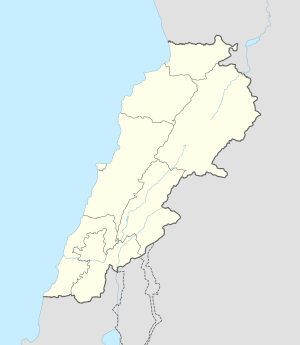Jarmaq
Jarmaq
جرمق | |
|---|---|
| Coordinates: 33°23′11″N 35°32′06″E / 33.38639°N 35.53500°E | |
| Grid position | 130/161 L |
| Country | |
| Governorate | South Governorate |
| District | Jezzine District |
| Elevation | 1,280 ft (390 m) |
| Time zone | UTC+2 (EET) |
| • Summer (DST) | +3 |
Jarmaq (جرمق) is a village in the Jezzine District in southern Lebanon, located 82 kilometers (51 mi) southeast of the capital Beirut. It is situated at the lower, western ridge of Mount Meron, overlooking the Sea of Galilee.[1] It has an altitude of 390 meters (1,280 ft). Its land area is 448 hectares.[2]
History
[edit]The Syrian geographer Yaqut al-Hamawi (d. 1226) mentioned that Jarmaq was a district of Safed and the site of an ancient town by the same name. Yaqut notes a Hebrew tribe was called after the town.[3]
In the 1596 tax records, it was named as a village, Jarman, in the Ottoman nahiya (subdistrict) of Shaqif Arnun, part of Safad Sanjak, with a population of 52 households and 6 bachelors, all Muslims. The villagers paid taxes on goats and beehives, "occasional revenues", a press for olive oil or grape syrup, "dulab", in addition to a fixed sum; a total of 5,502 akçe.[4][5]
Jarmaq was a Druze village, which began to decline in the 1830s, with Edward Robinson calling it "almost deserted".[1] In 1877 it was described as "a small, half-ruined village of stone" with thirty Druze inhabitants.[1] The inhabitants emigrated to the Hauran in the following decade. Jarmaq is the ancestral village of the eponymous Jarmaqani family resident in modern Salkhad, al-Qurayya and Urman.[1]
Following the 1982 invasion Jarmaq became part of the Israeli Security Zone. On 5 April 1992 Israeli soldiers shot dead two guerillas planting a roadside bomb in Jarmaq. Five Israeli soldiers had been killed in first 14 weeks of 1992.[6]
References
[edit]- ^ a b c d Firro 1992, p. 167.
- ^ "Jarmaq". Localliban. 6 July 2007. Retrieved 30 September 2020.
- ^ Strange 1890, p. 462.
- ^ Hütteroth and Abdulfattah, 1977, p. 185
- ^ Note that Rhode, 1979, p.6 Archived 2019-04-20 at the Wayback Machine writes that the register that Hütteroth and Abdulfattah studied was not from 1595/6, but from 1548/9.
- ^ Middle East International No 423, 17 April 1992, Publishers Lord Mayhew, Dennis Walters MP; Gerald Butt p.12
Bibliography
[edit]- Firro, Kais (1992). A History of the Druzes. Vol. 1. BRILL. ISBN 9004094377.
- Hütteroth, W.-D.; Abdulfattah, K. (1977). Historical Geography of Palestine, Transjordan and Southern Syria in the Late 16th Century. Erlanger Geographische Arbeiten, Sonderband 5. Erlangen, Germany: Vorstand der Fränkischen Geographischen Gesellschaft. ISBN 3-920405-41-2.
- Rhode, H. (1979). Administration and Population of the Sancak of Safed in the Sixteenth Century. Columbia University. Archived from the original on 2019-04-20. Retrieved 2017-12-04.
- Strange, G. le (1890). Palestine Under the Moslems: A Description of Syria and the Holy Land from A.D. 650 to 1500. Committee of the Palestine Exploration Fund.
External links
[edit]- Jarmaq, Localiban


